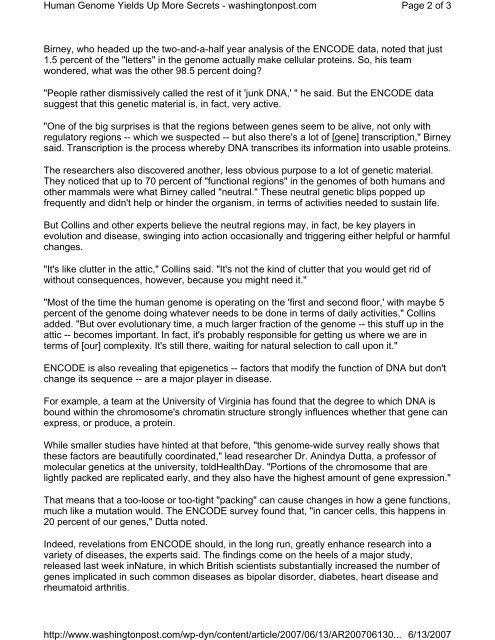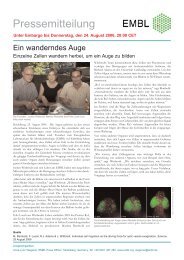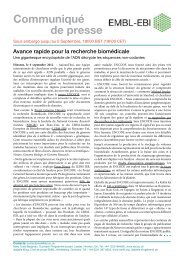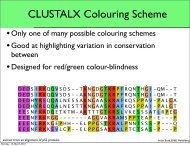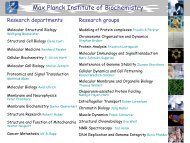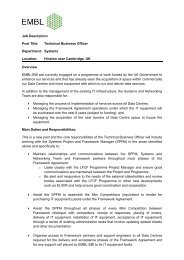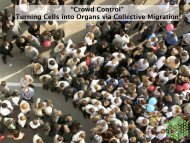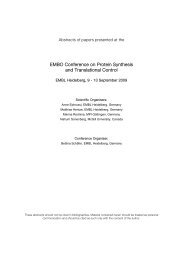Media Clips - EMBL
Media Clips - EMBL
Media Clips - EMBL
You also want an ePaper? Increase the reach of your titles
YUMPU automatically turns print PDFs into web optimized ePapers that Google loves.
Human Genome Yields Up More Secrets - washingtonpost.com<br />
Page 2 of 3<br />
Birney, who headed up the two-and-a-half year analysis of the ENCODE data, noted that just<br />
1.5 percent of the "letters" in the genome actually make cellular proteins. So, his team<br />
wondered, what was the other 98.5 percent doing?<br />
"People rather dismissively called the rest of it 'junk DNA,' " he said. But the ENCODE data<br />
suggest that this genetic material is, in fact, very active.<br />
"One of the big surprises is that the regions between genes seem to be alive, not only with<br />
regulatory regions -- which we suspected -- but also there's a lot of [gene] transcription," Birney<br />
said. Transcription is the process whereby DNA transcribes its information into usable proteins.<br />
The researchers also discovered another, less obvious purpose to a lot of genetic material.<br />
They noticed that up to 70 percent of "functional regions" in the genomes of both humans and<br />
other mammals were what Birney called "neutral." These neutral genetic blips popped up<br />
frequently and didn't help or hinder the organism, in terms of activities needed to sustain life.<br />
But Collins and other experts believe the neutral regions may, in fact, be key players in<br />
evolution and disease, swinging into action occasionally and triggering either helpful or harmful<br />
changes.<br />
"It's like clutter in the attic," Collins said. "It's not the kind of clutter that you would get rid of<br />
without consequences, however, because you might need it."<br />
"Most of the time the human genome is operating on the 'first and second floor,' with maybe 5<br />
percent of the genome doing whatever needs to be done in terms of daily activities," Collins<br />
added. "But over evolutionary time, a much larger fraction of the genome -- this stuff up in the<br />
attic -- becomes important. In fact, it's probably responsible for getting us where we are in<br />
terms of [our] complexity. It's still there, waiting for natural selection to call upon it."<br />
ENCODE is also revealing that epigenetics -- factors that modify the function of DNA but don't<br />
change its sequence -- are a major player in disease.<br />
For example, a team at the University of Virginia has found that the degree to which DNA is<br />
bound within the chromosome's chromatin structure strongly influences whether that gene can<br />
express, or produce, a protein.<br />
While smaller studies have hinted at that before, "this genome-wide survey really shows that<br />
these factors are beautifully coordinated," lead researcher Dr. Anindya Dutta, a professor of<br />
molecular genetics at the university, toldHealthDay. "Portions of the chromosome that are<br />
lightly packed are replicated early, and they also have the highest amount of gene expression."<br />
That means that a too-loose or too-tight "packing" can cause changes in how a gene functions,<br />
much like a mutation would. The ENCODE survey found that, "in cancer cells, this happens in<br />
20 percent of our genes," Dutta noted.<br />
Indeed, revelations from ENCODE should, in the long run, greatly enhance research into a<br />
variety of diseases, the experts said. The findings come on the heels of a major study,<br />
released last week inNature, in which British scientists substantially increased the number of<br />
genes implicated in such common diseases as bipolar disorder, diabetes, heart disease and<br />
rheumatoid arthritis.<br />
http://www.washingtonpost.com/wp-dyn/content/article/2007/06/13/AR200706130...<br />
6/13/2007


